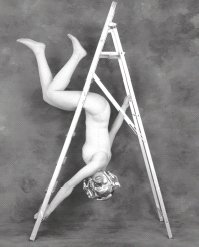articles/Printing/blackwhitemagic-page1
Black and White Magic - part 1 of 1 2 3
by Winston Ingram Published 01/02/2001

I think it was a very bold move and a very wise move for the Society to go for an all black and white magazine. The one thing that will survive in photography longer than any other medium is black and white, because it is the fine art side. But not many people seem to be able to produce really good black and white prints and I think the art bit is beginning to become lost. In this article I am going to concentrate on the production of first class black and white prints and negatives.
Of course it is important to have your exposure and lighting correct when you take the photograph, and the composition will be in the eye of the beholder. But after that you don't want to spoil your good work in the studio or on location by making a mess in the darkroom.
As far as chemistry is concerned for developing negatives and making prints, a lot of it is very personal choice, but once you've hit on a system you like, then it's always best to stick to it - unless something absolutely incredible is developed further in the future. For negatives I use the Foto-speed black and white fine grain developer FD10. I find that 50ml to 500ml (a 10% solution) per film is the ideal quantity.
The temperature should be between 21 and 25° C which gives you quite a good latitude.
The development time is the only thing that is changeable and depending upon the make and speed of the film this can vary, but of course charts are available from the various manufacturers. I find that for Ilford Delta or Ilford FP4+ (which are my two favourite choices of film) 5 minutes is quite adequate.
It's very important to agitate continually and even more important to make sure that you start agitating the moment you pour the developer into the tank and put on the lid. The next thing you need to do (and now temperatures are not at all critical providing the water is approx 20° C) is to give the film a rinse so that you remove all of the developer. This is for a maximum of 2 - 3 minutes depending on the size of your tank. After this I use a pre-mixed solution for the fixer, which is 30% and I use Foto-speed rapid fixer. The tank quantity of course is the same; 50ml to 500ml of water per film.

This should also be continually agitated for 5 minutes. The final step and be no means the least important is the washing, which needs to be for 20 minutes for archival quality. Then of course you dry your film off and the end result should be a very nicely developed negative.
If you are developing film for other people, as a guideline of proof that you've developed a film properly - and this applies to colour films as well - the rebate is also developed at the same time as you develop the image on the film and this should be a nice strong readable black of the negative number irrespective of the sharpness of the image in the negative.
Now we come to printing. So many picturesare ruined by people rushing the process. It's very easy - you once again have two solutions and of course water. The paper developer is made up of 50ml of developer to 500ml of water which will be sufficient to fill a 12" x 10" dish.
If you are using a larger dish e.g. 20" x 16" you will need 200ml of developer to 2ltr of water.
I personally use the Foto-speed DV10 which I find an extremely good paper developer and this can be used on either fibre based or resin coated papers and also multi-grade or graded paper it doesn't matter, but of course the times will vary. The times that I am quoting here will be for resin coated multi-grade emulsion. The developer should be at 21 deg. C and you should agitate the dish continually for 2 minutes. If you take a print out before the 2 minutes are up, it will not be properly or archival developed and you could get poor blacks and not very good whites. In other words your shadow and highlight detail will suffer. You should always make a test strip first. Some people use the step system, that is to take a larger test strip and make exposures for example as 5 seconds, 10 seconds, and 15 seconds. I prefer to use an individual smaller test strip - I find it quicker and more accurate - because the brain, if you like, is not then confused by having to look at three or four different exposures at once, which could be quite close. Having got your test strip correct for your exposure, you then need to decide if your grade or contrast is correct (I'll come back to that later). The next step is to rinse the print, 10 seconds in water is quite adequate and then place it straight into the fixer which once again is Foto-speed rapid fix (once again a 10% solution) and I leave this in for three minutes. The first two minutes under safe lights but for the last minute the overhead light can be put on and if everything is o.k. this gives me a chance to expose my next negative while for the last minute, the print is archival fixing. I then allow my prints to wash until the very end. You must give every print a minimum of two minutes from the last print you put in the sink. When you put a new print in the sink to wash you can possibly contaminate those already in there with fixing solution, so it is best to let them all rinse for two minutes after the last print has been added.
You are currently on page 1 Contact Winston Ingram
1st Published 01/02/2001
last update 09/12/2022 14:51:46
More Printing Articles
There are 17 days to get ready for The Society of Photographers Convention and Trade Show at The Novotel London West, Hammersmith ...
which starts on Wednesday 14th January 2026





